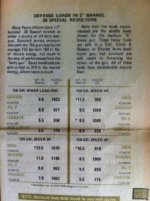I have to confess my ignorance, I am a fairly new shooter and am not familiar with this edition of the Speer manual but I take it there are some questionable loads shown?
It appears to be a continual source of debate among the more educated around here.
Can you folks share how this came to be and why people still discuss it?
It appears to be a continual source of debate among the more educated around here.
Can you folks share how this came to be and why people still discuss it?

